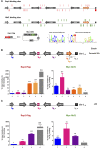Chromatin Loop Formation Induced by a Subtelomeric Protosilencer Represses EPA Genes in Candida glabrata
- PMID: 30002080
- PMCID: PMC6116953
- DOI: 10.1534/genetics.118.301202
Chromatin Loop Formation Induced by a Subtelomeric Protosilencer Represses EPA Genes in Candida glabrata
Abstract
Adherence, an important virulence factor, is mediated by the EPA (Epithelial Adhesin) genes in the opportunistic pathogen Candida glabrata Expression of adhesin-encoding genes requires tight regulation to respond to harsh environmental conditions within the host. The majority of EPA genes are localized in subtelomeric regions regulated by subtelomeric silencing, which depends mainly on Rap1 and the Sir proteins. In vitro adhesion to epithelial cells is primarily mediated by Epa1. EPA1 forms a cluster with EPA2 and EPA3 in the right telomere of chromosome E (E-R). This telomere contains a cis-acting regulatory element, the protosilencer Sil2126 between EPA3 and the telomere. Interestingly, Sil2126 is only active in the context of its native telomere. Replacement of the intergenic regions between EPA genes in E-R revealed that cis-acting elements between EPA2 and EPA3 are required for Sil2126 activity when placed 32 kb away from the telomere (Sil@-32kb). Sil2126 contains several putative binding sites for Rap1 and Abf1, and its activity depends on these proteins. Indeed, Sil2126 binds Rap1 and Abf1 at its native position and also when inserted at -32 kb, a silencing-free environment in the parental strain. In addition, we found that Sil@-32kb and Sil2126 at its native position can physically interact with the intergenic regions between EPA1-EPA2 and EPA2-EPA3 respectively, by chromosome conformation capture assays. We speculate that Rap1 and Abf1 bound to Sil2126 can recruit the Silent Information Regulator complex, and together mediate silencing in this region, probably through the formation of a chromatin loop.
Keywords: Candida glabrata; EPA genes; Rap1; chromatin loop; cis-elements; protosilencer; transcriptional regulation.
Copyright © 2018 by the Genetics Society of America.
Figures









Similar articles
-
Abf1 negatively regulates the expression of EPA1 and affects adhesion in Candida glabrata.J Med Microbiol. 2024 Oct;73(10). doi: 10.1099/jmm.0.001905. J Med Microbiol. 2024. PMID: 39360930
-
A protosilencer of subtelomeric gene expression in Candida glabrata with unique properties.Genetics. 2012 Jan;190(1):101-11. doi: 10.1534/genetics.111.135251. Epub 2011 Nov 2. Genetics. 2012. PMID: 22048024 Free PMC article.
-
A novel downstream regulatory element cooperates with the silencing machinery to repress EPA1 expression in Candida glabrata.Genetics. 2012 Apr;190(4):1285-97. doi: 10.1534/genetics.111.138099. Epub 2012 Jan 10. Genetics. 2012. PMID: 22234857 Free PMC article.
-
Local and regional chromatin silencing in Candida glabrata: consequences for adhesion and the response to stress.FEMS Yeast Res. 2015 Sep;15(6):fov056. doi: 10.1093/femsyr/fov056. Epub 2015 Jun 29. FEMS Yeast Res. 2015. PMID: 26122277 Review.
-
The mating type-like loci of Candida glabrata.Rev Iberoam Micol. 2014 Jan-Mar;31(1):30-4. doi: 10.1016/j.riam.2013.09.016. Epub 2013 Nov 16. Rev Iberoam Micol. 2014. PMID: 24252826 Review.
Cited by
-
Telomeric and Sub-Telomeric Structure and Implications in Fungal Opportunistic Pathogens.Microorganisms. 2021 Jun 29;9(7):1405. doi: 10.3390/microorganisms9071405. Microorganisms. 2021. PMID: 34209786 Free PMC article. Review.
-
Chromatin architecture and virulence-related gene expression in eukaryotic microbial pathogens.Curr Genet. 2019 Apr;65(2):435-443. doi: 10.1007/s00294-018-0903-z. Epub 2018 Nov 15. Curr Genet. 2019. PMID: 30443783 Review.
-
Abf1 Is an Essential Protein That Participates in Cell Cycle Progression and Subtelomeric Silencing in Candida glabrata.J Fungi (Basel). 2021 Nov 25;7(12):1005. doi: 10.3390/jof7121005. J Fungi (Basel). 2021. PMID: 34946988 Free PMC article.
-
Subtelomeric Chromatin Structure by Chromosome Conformation Capture (3C)-qPCR Methodology in Candida glabrata.Methods Mol Biol. 2022;2542:71-89. doi: 10.1007/978-1-0716-2549-1_5. Methods Mol Biol. 2022. PMID: 36008657
-
Candida glabrata Antifungal Resistance and Virulence Factors, a Perfect Pathogenic Combination.Pharmaceutics. 2021 Sep 22;13(10):1529. doi: 10.3390/pharmaceutics13101529. Pharmaceutics. 2021. PMID: 34683822 Free PMC article. Review.
References
-
- Ausubel, F. M., Brent R., Kingston R. E., Moore D. D., Seidman J. G. et al. , (Editors) 2001. Current Protocols in Molecular Biology. John Wiley & Sons, Hoboken, NJ.
Publication types
MeSH terms
Substances
LinkOut - more resources
Full Text Sources
Other Literature Sources
Research Materials

